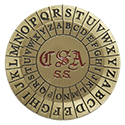8. Referencias
Ult. rev. 02-02-2023
- BAUER, F. L., Decrypted Secretsthods and Maxims of Cryotology, 4th Ed., Springer Verlag, Ber- lin, 2007.
- CEANO, R., La Máquina Enigma, Documentos y manuales Enigma, 2012. (Última con- sulta 20-11-2012)
- COOMBS, A. W. H., The Making of Colossus, Annals of the History of Computing, Volume 5, Number 3, july 1983.
- COPELAND, J., Colossus: Its Origins and Originators, Annals of the History of Computing, pp. 38–44, Computer Society, UK, 2004.
- CHRISTENSEN, C., Polish Mathematicians Finding Patterns in Enigma Messages, Mathematics Magazine, Nº. 80, pp. 247–273, october 2007.
- FERNÁNDEZ, S., La Criptografía Clásica, Revista SIGMA, Nº. 24, pp. 119–141, abril 2004.
- FLOWERS, T. H., The Design of Colossus, Annals of the History of Computing, Volume 5, Number 3, july 1983.
- GAJ, K., ORLOWSKI, A. Facts and myths of Enigma: breaking stereotypes, EUROCRYPT’03 Pro- ceedings of the 22nd international conference on Theory and applications of cryptographic techniques, Springer-Verlag, Berlin, Heidelberg, pp. 106–122, 2003.
- HODGES, A., The Military Use of Alan Turing, Mathematics and War, pp. 312–325, Bernhelm Booss Bavnbek and Jens Høyrup Editors, Birkhäuser, 2003.
- KERCKHOFFS, A., La cryptographie militaire, Journal des sciences militaires, vol. IX, pp. 5— 83, jan. 1883, pp. 161—191, fév. 1883.
- KOZACZUK, W., ENIGMA: The Key to the Secrets of the Third Reich 1933-45, Interpress, june 1984.
- LAHOZ-BELTRA, R., Turing: Del primer ordenador a la inteligencia artificial, Colección: La ma- temática y sus personajes, Nº. 24, 1ª Edición. Nívola, Madrid, 2005.
- MEDRALA, J., L'Enigma polonaise en Résistance á Uzés 1940-1942. Une aventure humaine pres- tigieuse et dramatique, Conférence Enigma: S'il te plait dessine-moi la Pologne, Paris, 2008.
- MILLER, A. R., The Criptographic Mathematics of Enigma, Center for Cryptologic History, 1996.
- ORTEGA TRIGUERO, J.J., LÓPEZ GUERRERO, M.A. y GARCÍA DEL CASTILLO CRESPO, E.C., Introducción a la Criptografía. Historia y Actualidad, Servicio de Publicaciones de la Universidad de Castilla La Mancha, Colección Monografías, Nº. 50, 2006.
- QUIRANTES SIERRA, A., Enigma: la solución polaca (I) y (II), Boletín del Taller de Criptología, Nº. 18, diciembre 2003.
- RANDEL, B., The Colossus, International Research Conference on the History of Computing, Los Alamos Scientific Laboratory, University of California, June 10-15th, 1976.
- REJEWSKI, M., An Application of the Theory of Permutations in Breaking the Enigma Cipher, Applicaciones Mathematicae. 16, Nº. 4, Warsaw 1980.
- REJEWSKI, M., How Polish Mathematicians Deciphered the Enigma, Annals of the History of Computing. Volume 3. Number 3, July 1981.
- SÁNCHEZ MUÑOZ, J. M., Nazis y Matemáticas, 2ª Jornada Internacional “Matemáticas Everywhere”, Castro Urdiales, 20–21 junio, 2012.
- SINGH, S., Los Códigos Secretos: El arte y la ciencia de la criptografía, desde el antiguo Egipto a la era Internet, Editorial Debate, 2000.
- TUTTE, W. T., Fish and I, Transcripcción de Conferencia en la Universidad de Waterloo (19 de junio de 1998), Ontario, Canadá, 2012.
- UNIÓN INTERNACIONAL DE TELECOMUNICACIONES, Reglamento Telegráfico, Revisión de Gi- nebra, 1958, Anexo al Convenio Internacional de Telecomunicaciones, Buenos Aires, 1952, Protocolo Final, Ginebra, 1959.
- VV.AA, The History of Information Security: A Comprehensive Handbook, Karl de Leeuw y Jan Bergstra (Editores), Elsevier B.V., 2007.
- WESOLKOWSKI, S., The Invention of Enigma and How the Polish Broke It Before the Start of WWII. IEEE Conference on the History of Telecommunications, University of Waterloo, Ca- nada, 2001.
- José Manuel Sánchez Muñoz, jmanuel.sanchez@gmx.es, Ingeniero de Caminos, Canales y Puertos. Grupo de Innovación Educativa “Pensamiento Matemático”, Universidad Politécnica de Madrid, España.
Artículo revisado y actualizado por este sitio web
Véase también
Principal
Siguiente ![]()
